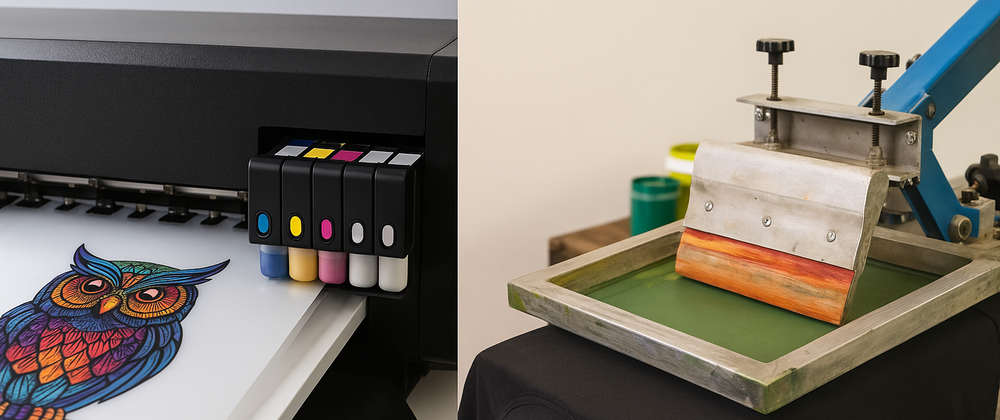In the expanding world of textile customization, Direct-to-Film (DTF) printing has emerged as a powerful option for high-quality, full-color transfers on fabric. As small businesses and print shops turn to DTF for its affordability and versatility, there's one often overlooked element that can make or break the final output: RIP software.
RIP stands for Raster Image Processor, and it plays a far more technical role than simply telling your printer what to do. The software handles how your digital design is translated into printable data—controlling everything from ink layering to color calibration. Without a well-configured RIP workflow, even the best DTF printer and inks will fall short of delivering professional results.
Let’s break down exactly how RIP software affects the quality of your DTF prints.
1. White Ink Management
One of the defining features of DTF printing is the ability to print on dark or colored garments thanks to the white underbase layer. RIP software determines where, how much, and how dense the white ink should be.
If the white ink layer is too thin, colors appear dull or washed out. If it’s too thick, it can lead to stiffness, over-saturation, or ink bleeding. The RIP software generates the white layer separately and allows users to fine-tune its coverage beneath specific design elements.
This level of control is essential for vibrant colors, smooth texture, and even adhesion when heat pressing the transfer onto fabric.
2. Color Accuracy and ICC Profiling
Color management is critical in DTF printing, especially if you’re printing for clients or dealing with brand-specific colors. RIP software uses ICC (International Color Consortium) profiles to ensure what you see on your screen closely matches the final printed result.
Without RIP software—or with poorly configured settings—you may experience:
Color shifts (e.g., reds appearing orange)
Inconsistent tones across multiple prints
Washed-out gradients or highlights
By correctly applying ICC profiles and linearization curves, RIP software helps achieve color consistency across batches and substrates.
3. Rasterization and Halftone Control
Digital designs are made up of pixels, but printers operate by spraying tiny droplets of ink. RIP software translates high-resolution designs into rasterized formats that the printer can reproduce.
Advanced RIP systems also provide halftoning options, which influence how tones and gradients are represented using dot patterns. This affects the sharpness, smoothness, and clarity of the image—particularly in photographic prints, skin tones, or detailed artwork.
Improper halftoning settings can result in visible patterns, graininess, or poor gradient transitions.
4. Ink Droplet and Pass Control
Not all RIP software allows for fine-tuned control over ink droplets, but the best ones do. These settings affect how many passes the printer makes over a section of the film and what size droplets are used.
Fewer passes = faster print speed, but lower quality
More passes = slower, but more detailed and consistent output
Similarly, droplet size affects how sharp or saturated the image appears. Small droplets are ideal for intricate detail, while larger ones might be suitable for bold, simple graphics. RIP software makes it possible to balance speed with precision, depending on your job needs.
5. Layout and Job Nesting
Another practical way RIP software impacts print quality is through layout optimization. Most RIP applications allow you to arrange multiple designs on a single sheet of film, minimizing waste and ensuring consistent spacing.
This helps with:
Efficient film usage
Uniform heat application during curing
Reduced risk of misalignment or stretching
Although this is more about production efficiency than visual quality, cleaner workflows lead to more consistent results—especially important for bulk or repeat jobs.
6. Layering Sequence and Output Control
In DTF printing, every transfer consists of multiple layers—typically a color layer and a white layer. Advanced RIP software manages the order and timing of these layers to ensure they align perfectly.
Some RIP tools even support printing of a "mirror image" automatically, so you don’t have to flip designs manually. These subtle tasks can prevent mistakes that result in reversed prints or misaligned transfers.
The better the software manages the sequencing, the cleaner and crisper the final print appears on fabric.
7. Spot Color and Transparency Handling
RIP software allows for customization of spot colors—specific ink formulations outside the standard CMYK range. This feature is especially useful for logos, brand assets, or specialty effects.
Additionally, RIP software is critical for interpreting transparency correctly. Many beginners make the mistake of printing PNGs with transparent backgrounds without configuring how those areas should be treated. RIP software can detect and preserve transparent zones to avoid unwanted background artifacts.
Why Cheap or Basic RIP Software Can Hold You Back
There are free or low-cost RIP solutions available, but they often lack advanced controls. In some cases, they might only provide basic color management or offer limited support for white ink.
This can result in:
Ink oversaturation
Color mismatches
Poor print durability
Wasted film and ink
Investing in a solid RIP tool—like Cadlink Digital Factory, EKPrint Studio, or AcroRip—can unlock your printer’s full potential. It also reduces the learning curve by offering built-in templates and presets designed for common DTF workflows.
Conclusion: A Crucial Tool for Professional Results
RIP software is the engine behind every successful DTF print. While hardware and ink matter, your software dictates how effectively those tools are used. It governs how ink behaves, how colors are formed, and how layers align—all of which are crucial to the visual impact and wearability of the final garment.
If you're serious about DTF printing—whether you're just starting out or upgrading your operation—learning your RIP software and using it to its full capacity is one of the best moves you can make.
Understanding how it works isn't just technical know-how—it's the difference between a basic print and a professional-quality product.



Top comments (3)
Great breakdown on how crucial RIP software is for achieving consistent, high-quality DTF prints. The points on white-ink control, ICC profiling, and halftoning perfectly highlight how software precision directly impacts final output. This level of workflow optimization is just as important in 3D printing, where proper slicing ensures clean layers and accurate results. For those exploring similar tools in the 3D print space, Visit Now for more advanced workflow solutions.
Great explanation of why RIP software matters so much for DTF printing. The way it controls white ink layers and color profiles really is the difference between average and professional results. If you’re also working on upgrades beyond the print shop like refreshing your space a trusted home remodeling company can help you create a setup that’s as polished as your finished prints.
Super informative! Just like a well-balanced meal, the right RIP software is essential to get the perfect final result — it ties everything together for a smooth, professional finish.